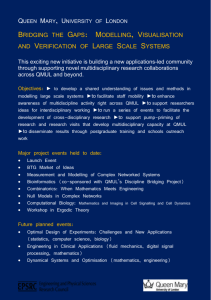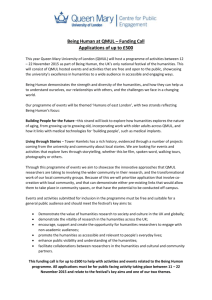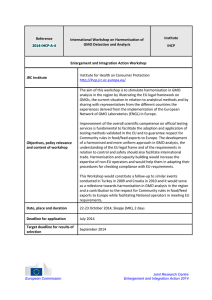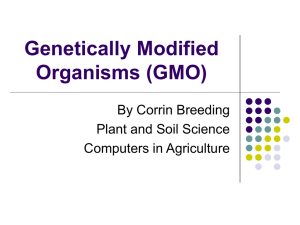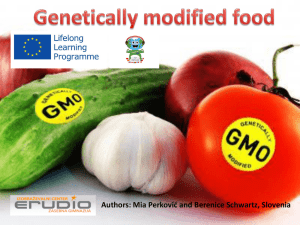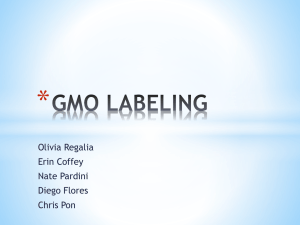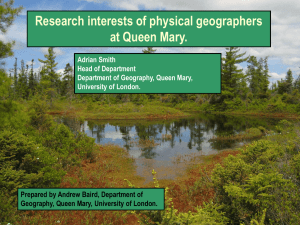Genetic Modification Risk Assessment
advertisement
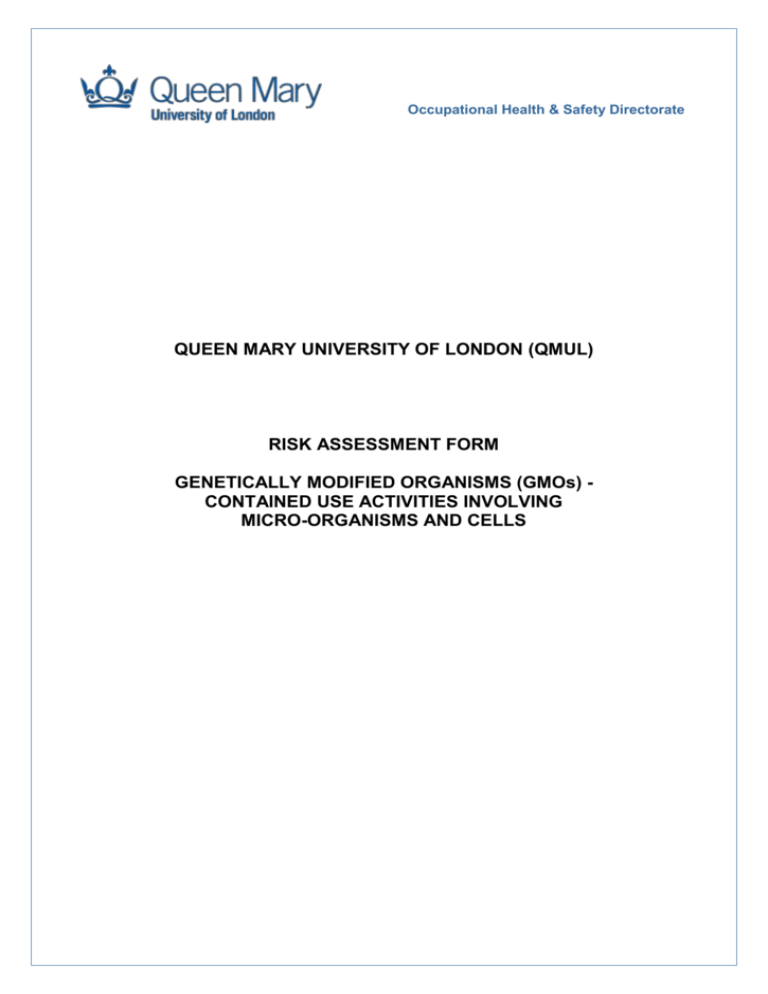
Occupational Health & Safety Directorate QUEEN MARY UNIVERSITY OF LONDON (QMUL) RISK ASSESSMENT FORM GENETICALLY MODIFIED ORGANISMS (GMOs) CONTAINED USE ACTIVITIES INVOLVING MICRO-ORGANISMS AND CELLS Ref: 774/ GM Class: Date Approved: As required under Regulation 5 of the GENETICALLY MODIFIED ORGANISMS (CONTAINED USE) REGULATIONS 2014 INFORMATION ON THIS PAGE IS CONFIDENTIAL 1. PROJECT SUPERVISOR (Person who has overall responsibility for the work. Include Name, full address, e-mail and telephone number/s) 2. DEPUTY PROJECT SUPERVISOR (Responsible person in the absence of the project supervisor. Include Name, full address, email and telephone number/s) 3. LABORATORY / ROOM / FACILITY WHERE THE WORK WILL BE CARRIED OUT (Please identify all rooms / facilities where GMO’s will be handled and stored, including the name of the QMUL Building/s and Campus location) 4. DESCRIPTIVE TITLE OF PROJECT (No more than one or two sentences) QM_OHSD_SE021_April 2015 GMO Contained Use Risk Assessment Template 2 Ref: 774/ 5. GM Class: Date Approved: PROJECT SUMMARY FOR LAY REVIEWERS Provide a short (one or two paragraphs) summary which describes in terms understandable to a LAY PERSON, the nature and aims of the project, and why the use of GMO / GMMs is important for this work. In lay terms, note which feature(s) of the work produces significant risk(s) to human health and the environment, and what containment measures are appropriate. Identify and explain the level of risk posed to human health and the environment. 6. SCIENTIFIC OVERVIEW OF PROJECT (Please complete a brief scientific resume of the project. Additional information can be attached if necessary) QM_OHSD_SE021_April 2015 GMO Contained Use Risk Assessment Template 3 Ref: 774/ 7. GM Class: Date Approved: ORGANISMS AND VECTORS (Please list the organism, vectors and inserts that will be used in the project, this should include the source. This can be done in generic terms where appropriate e.g. K12 strains. For cell cultures, give strain/line information as well as species. If GMOs / GMMs have been imported into the site, information on the construction of the GMO / GMM must be obtained from the supplier) 8. IDENTIFICATION OF POTENTIAL HARMFUL EFFECTS AND HAZARDS IN RESPECT OF HUMAN HEALTH (This section looks at the possible harmful effects/hazards to human health from the pathogenicity, biological effects and toxicity of the host organism, foreign gene product and the mobility of the plasmid. Therefore consider host, vector, final GMO / GMM and survivability. Also severity of effects if an accident was to occur) 9. IDENTIFICATION OF POTENTIAL HARMFUL EFFECTS AND HAZARDS TO THE ENVIRONMENT (This section considers the possible harmful effects/hazards to the environment. What is the likelihood of release/escape of organism from the containment laboratory? Consider host, vector, final GMO / GMM, scale and survivability. Also severity/consequences if an accident was to occur) QM_OHSD_SE021_April 2015 GMO Contained Use Risk Assessment Template 4 Ref: 774/ 10. GM Class: Date Approved: ASSIGNMENT OF PROVISIONAL CONTAINMENT LEVEL (This considers the Containment Level necessary to control risk of host and by making a judgment about whether the modification(s) carried out will result in a GMO / GMM, which is more/less hazardous, or about the same) (Select) Containment Level 1 / 2 / 3 (For assignment of a Containment Level see section 24 below ‘Assignment of a Containment Level to control the risk’ and for a summary table of Containment Levels RequirementsAppendix 2: GMMs in Contained Use Laboratories - Containment Level Measures in the QMUL GM Standard http://www.ohsd.qmul.ac.uk/documents/standard/sem/148857.docx) If certain parts of the work (e.g. gene cloning) can be conducted at a lower Containment Level than that selected above, clearly identify those parts of the work here: 11. POSSIBILITY (LIKELIHOOD) OCCURING: RISK TO HUMANS OF THE ABOVE EFFECTS (Consider the scale of cultures used and their frequency, production of aerosols, use of sharps, any other hazardous procedures) Use the risk estimation table in Section 24 ‘notes for guidance’: Likelihood …….. X Consequence……Overall Risk to human health =……. QM_OHSD_SE021_April 2015 GMO Contained Use Risk Assessment Template 5 Ref: 774/ 12. GM Class: Date Approved: POSSIBILITY (LIKELIHOOD) OF THE ABOVE OCCURING: ENVIRONMENTAL CONSIDERATIONS EFFECTS (Consider theoretical modes of transmission (e.g. drains, air), can the environment support the survival of the GMO / GMM, are there species in the environment, which are susceptible to infection by the GMO / GMM; Use the risk estimation table under ‘notes for guidance’) Use the risk estimation table in Section 24 ‘notes for guidance’: Likelihood …….. X Consequence……Overall Risk to the Environment =……. 13. DOES THE LABORATORY / FACILITY MEET THE REQUIREMENTS FOR SMALL SCALE ACTIVITIES INVOLVING GMO / GMM CONTAINED USE? (select) Yes / No If ‘Yes’ is selected, you are attesting that the laboratory / facility and work arrangements meet the requirements for the appropriate Containment Level as noted in the Regulations. (See Containment Level Requirements in Appendix 2 of the QMUL GM Standard http://www.ohsd.qmul.ac.uk/documents/standard/sem/148857.docx) 14. WASTE CONTROL (GMO / GMM contaminated waste (Class 2 or 3) must be rendered non-viable (autoclaving for solid, validated disinfectant treatment for liquid before removal or disposal from the premises; Class 1 waste can be disposed directly into authorised clinical waste stream or disposed after disinfectant inactivation. This ensures that any contact between GMOs / GMMs and the environment is limited to an extent commensurate with the risks identified in the risk assessment, and provides a high level of protection for humans and the environment. Consider the degree of kill offered by the inactivation method (e.g. disinfectant inactivates 5 log of GMO / GMM) and any proposed testing / monitoring measures that may be required. (Further information on QMUL clinical / GMO waste arrangements are detailed in section 18 of the QMUL GM Standard). QM_OHSD_SE021_April 2015 GMO Contained Use Risk Assessment Template 6 Ref: 774/ 15. GM Class: Date Approved: ARE ALL WORKERS FAMILIAR WITH LOCAL RULES AND GM REGULATIONS ON SAFE WORKING AND WASTE DISPOSAL METHODS? [Specific worker training records for GM work at Class 2 (as the risk assessment identifies) and Class 3 must be kept] Yes / No 16. ASSIGNMENT OF CONTAINMENT LEVEL AND CLASS (After considering all the activity and environmental considerations into account revise, if necessary, the provisional containment level so that all risks are controlled. Please note that work classified as GM Class 1 cannot start until approval from QMUL GMSC has been granted; additionally, work assessed as GM Class 2 or above will need specific HSE notification AND approval / consent, and also may require additional information and laboratory / facility inspections; work likely to classify as GM Class 4 is NOT permitted at QMUL). Containment level…………… Class…………… All projects must be reviewed regularly to ensure that the risk assessment is still valid and that the work has not changed significantly – If this is the case, the project must be re-assessed – see section 25. 17. ADDITIONAL ASSESSMENTS This should include where appropriate: i. Completion of the Environmental Risk Assessment (for low risk / transgenic GMO animal models) http://www.ohsd.qmul.ac.uk/documents/1/70929.doc ii. Has the above project been assessed under the COSHH regulations, in terms of chemical, biological safety and other risks? iii. If using radioactivity, has this been assessed and approved? iv. Have all health surveillance requirements for individuals relevant to the GM and associated project work been assessed? (see section 22 below for further assistance) v. Any other relevant information not covered above. 18. COMMENTS OF THE GMSC (QMUL Biological Safety Adviser Use Only) (E.g. Biological Safety Adviser review comments, GMSC members Peer Review comments, amendments to be made, updates required) QM_OHSD_SE021_April 2015 GMO Contained Use Risk Assessment Template 7 Ref: 774/ GM Class: Date Approved: INFORMATION ON THIS PAGE IS CONFIDENTIAL 19. RISK ASSESSMENT PREPARED BY: ……………………………………… Name (In signing this you agree that work will not commence until QMUL GMSC approval and where required, HSE acknowledgement or approval / consent has been granted) Date ……………………………………… Signature ……………………………………… 20. APPROVED BY GMSC (QMUL Biological Safety Adviser Use Only) QMUL PROJECT REFERENCE NUMBER: 774 / Name ……………………………………… Date ……………………………………… Signature ……………………………………… 21. HSE APPROVAL (QMUL Biological Safety Adviser Use Only) HSE ACKNOWLDEGEMENT PROJECT REFERENCE AND DATE: HSE APPROVAL DATE (for Class 2): HSE CONSENT DATE (for Class 3): CONNECTED PROGRAM OF WORK DETAILS: QM_OHSD_SE021_April 2015 GMO Contained Use Risk Assessment Template 8 Ref: 774/ GM Class: Date Approved: 22 NOTES FOR GUIDANCE, AND WHERE TO OBTAIN FURTHER HELP Risk Assessment Completion QMUL Key Contacts: First point of call - QMUL Biological Safety Adviser: Dr Mark Ariyanayagam (m.r.ariyanayagam@qmul.ac.uk , tel 0207 882 8378) QMUL GMSC Chair: Dr Martin Carrier (m.j.carrier@qmul.ac.uk , tel 0207 882 2218 QMUL GMSC Deputy Chair: Dr Matthias Dittmar (m.t.dittmar@qmul.ac.uk , tel 0207 882 8119) QMUL GMSC members: names and contact details http://www.ohsd.qmul.ac.uk/mag/GM%20Safety%20Sub-committee/index.html This form can be obtained as a word file from the QMUL Occupational Health and Safety Directorate website (http://www.ohsd.qmul.ac.uk/forms/index.html ). Separate GM risk assessment forms are available for Deliberate Release GM projects, and work with Larger GMO’s (animals, plants) on the same website. In the first instance, completed forms should be sent as an attachment by e-mail to the QMUL Biological Safety Adviser. The form can be lengthened / shortened as required. Members of the QMUL GMSC can also provide guidance on the completion of this form. See the attached flowchart and the QMUL GM Standard for guidance and information on the risk assessment and approval process. The following documents / resources provide guidance for completion of the risk assessment: 1. The Genetically Modified Organisms (Contained Use) Regulations 2014 http://www.legislation.gov.uk/uksi/2014/1663/pdfs/uksi_20141663_en.pdf 2. The Scientific Advisory Committee on Genetic Modification (SACGM) Compendium of Guidance http://www.hse.gov.uk/biosafety/gmo/acgm/acgmcomp/ (In particular see Part 2: Risk assessment of genetically modified microorganisms (other than those associated with plants) [2.1MB] and Part 3: Containment and control of activities involving genetically modified microorganisms ) 3. QMUL GM Health and Safety Standard, Guidance and Arrangements http://www.ohsd.qmul.ac.uk/documents/standard/sem/148857.docx (In particular see sections 15, 17 and 19, and Appendix 2 for a summary of Containment Level requirements) and additional QMUL GMO resources at http://www.ohsd.qmul.ac.uk/ 4. Significant changes to a GM Contained Use Notification [Institute of Safety in Technology and Research (ISTR) guidance document] http://www.istr.org.uk/docs/ISTR%20BSG%20Significant%20Change%20guidance% 20v1.pdf 5. Additional HSE / SACGM GMO documents and resources http://www.hse.gov.uk/biosafety/gmo/information.htm 6. HSE / ACDP biological agents documents and resources http://www.hse.gov.uk/biosafety/information.htm Health Surveillance requirements QM_OHSD_SE021_April 2015 GMO Contained Use Risk Assessment Template 9 Ref: 774/ GM Class: Date Approved: To determine GM worker Health Surveillance requirements (for GM Class 3 activities and for others where a risk assessment determines), contact the QMUL Biological Safety Adviser for initial advice on requirements and the QMUL Occupational Health Department (tel 0207 882 8700) for registration and monitoring. Part 1, Pages 17-20 of the SACGM Compendium of Guidance details instances where Health Surveillance may be required for GM work (http://www.hse.gov.uk/biosafety/gmo/acgm/acgmcomp/part1.pdf ). Consequences of hazard Risk Estimation Table: Likelihood of Hazard High Medium Low Severe Modest High High Low / Minor M/L Negligible Effectively zero High Medium Medium M/L Low Low Effectively zero Effectively zero Negligibl e Effectively zero Effectively zero Effectively zero Effectively zero Assignment of a Containment Level to control the risk: GMO / GMM Contained Use Final Risk Evaluation Effectively zero risk to humans and/or the environment Low to medium risk to humans and/or the environment Medium risk to humans and/or the environment High risk to humans and/or the environment Containment necessary to control the Risk Risk Classification Level 1 Class 1 Level 1 with the addition of measures from Level 2 or Level 2 (without additional measures) Level 2 with the addition of measures from Level 3 or Level 3 (without additional measures) Level 3 with the addition of measures from Level 4 or Level 4 (without additional measures) Class 2 Class 3 This work cannot be conducted at QMUL QM_OHSD_SE021_April 2015 GMO Contained Use Risk Assessment Template 10 Ref: 774/ GM Class: Date Approved: Flowchart for the GMO Contained Use Risk Assessment and Regulatory Notification Process: QM_OHSD_SE021_April 2015 GMO Contained Use Risk Assessment Template 11 Ref: 774/ GM Class: Date Approved: PAGES INCLUDING SECTIONS 23-25 CAN BE REMOVED AND ATTACHED TO A NEW VERSION OF THE ASSESSMENT TO ENABLE WORKER RECORD TRANSFER AND RETENTION INFORMATION PROVIDED IN SECTIONS 23-25 IS CONFIDENTIAL 23 PROJECT RISK ASSESSMENT REVIEW. This assessment should be periodically reviewed and updated as necessary over the active life of the project. Reviews should be conducted at least once every 3 years, unless specified otherwise by the GMSC. Please forward the QMUL Biological Safety Adviser, the new version of the assessment and keep a copy of the old version for at least 10 years after work has ceased (‘work’ includes storage of GM material). Significant amendments require consideration and approval by the GMSC; GM Class 2 or 3 activities also require HSE approval. Cessation or move of a Project to another Institution requires notification to the QMUL Biological Safety Adviser / GMSC and for GM Class 2 or 3, also to the HSE. VERSION 24 DATE OF LAST REVIEW: SIGNATURE OF GM PROJECT SUPERVISOR GM PROJECT WORKERS To include qualifications, training and experience with GM work. All GM workers (and any others impacted by the work) should sign below in section 24 to indicate that the assessment has been read and understood. Updates in Project Workers should be notified to the QMUL Biological Safety Adviser by sending the updated pages for sections 23 - 25. Some GM workers (for GM Class 3 activities and others where a risk assessment determines) require Health Surveillance and the QMUL Occupational Health Service must be contacted to ensure adequate monitoring. See the QMUL GM Standard for further information and section 24 above for further information. FULL NAME QUALIFICATIONS GMO work experience (e.g. length of time, type of GMOs / vectors / microorganisms handled) QM_OHSD_SE021_April 2015 GMO Contained Use Risk Assessment Template 12 GM Training (e.g. Bio/GM safety courses at QMUL and previous Institutions, local /in house and external training) Ref: 774/ 25 GM Class: Date Approved: GM WORKERS AND ASSOCIATED STAFF / STUDENTS This risk assessment should be easily available (e.g. in the laboratory) and where it can be read by GM workers and others who may be significantly impacted by the work (e.g. those not on the project but working in close proximity in the same laboratory). All those working or significantly impacted by this project should read the assessment before beginning work. Sign below to indicate that you have read and understood the latest version of the assessment. If required, please extend the table to include more names. VERSION PRINT NAME SIGNATURE QM_OHSD_SE021_April 2015 GMO Contained Use Risk Assessment Template 13 DATE

